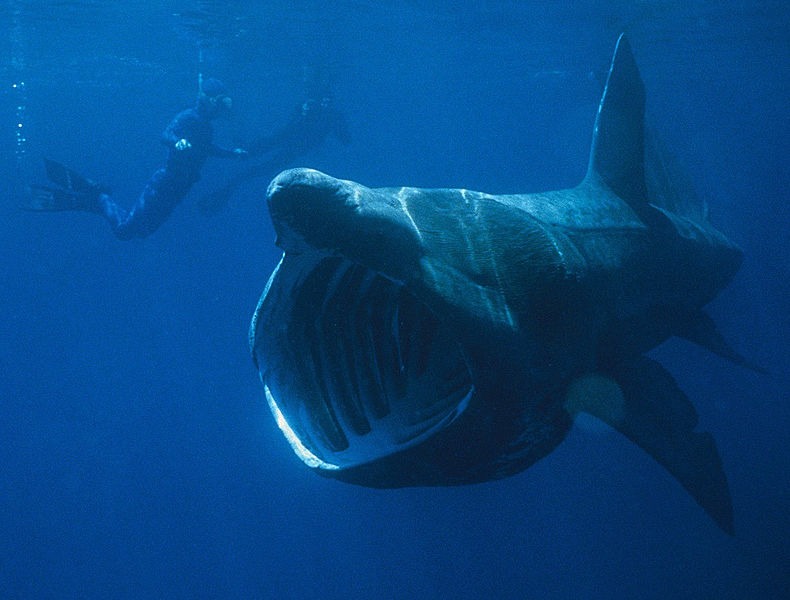You know how people say you should never judge a book by its cover? It’s possible that the person who coined that saying probably had basking sharks in mind. Their appearance is intimidating and large enough to scare off nearby swimmers and divers. So, it’s not surprising that people commonly refer to them as bone sharks.
It’s usually hard to predict where basking sharks live due to their secretive nature. However, careful studies show that their location per time largely depends on the climate in that area. This article explores this topic further, giving you an in-depth view of where to find basking sharks.
Where Do Basking Sharks Live?

The basking shark is found in British coastal waters between May and October.
©Chris Gotschalk / Public Domain, from Wikimedia Commons, the free media repository – License
Basking sharks are migratory species that can be found in every temperate ocean that exists in the world, even the Mediterranean Sea. This is primarily because they follow concentrations of zooplankton to feed. These plankton have been known to swell during the summer in each hemisphere. This makes them a large and tasty food source for basking sharks to feed on.
However, the main place you can find basking sharks is in the British coastal waters between May and October. This is because most basking sharks are more accustomed to warmer waters, so they migrate south during the winter. Some even travel as far as North Africa, while studies show evidence that some basking sharks undergo transatlantic migration. Notwithstanding, some of these sharks retain their unpredictable nature by remaining in Irish and British waters during the winter.
The coastal waters in Britain are the principal finding place for basking sharks as they are littered in various locations there. But they have been majorly sighted in Cornwall, western Scotland, the Isle of Man, and the western English Channel. Unlike other sharks like the goblin shark, basking sharks spend most of their summer at the sea’s surface, floating or moving slowly. This is how they got the name basking sharks. However, this doesn’t mean that they don’t also dive deep into those waters. Records have shown that basking sharks can dive to around 3,000 feet in the ocean’s twilight zone.
The unpredictability of basking sharks also reaches as far as the details regarding their reproduction. Not much is known about their reproduction, but many believe they’re ovoviviparous animals that give birth to live pups during the summer. But this doesn’t happen very often because they are slow breeders. They gestate for about two to three years, so they’re less likely to reproduce young ones like other shark species, leaving them open to the risk of extinction.
Do Basking Sharks Live In Cold Water?

Despite basking sharks’ liking for warmer waters, they still can adjust their body temperature to keep themselves warm in cold waters.
©rossbeane, CC BY-SA 2.0, via Wikimedia Commons – License
Generally, basking sharks have been known to live and thrive in warmer waters. However, some might choose to live in cold water during the winter, as long as the water doesn’t reach freezing point. Wide shark varieties are naturally endothermic animals. So, despite the basking sharks’ liking for warmer waters, they still can adjust their body temperature to keep themselves warm.
Basking sharks that remain during the winter have been known to change their behaviors to adapt to the cold. For example, they swim more slowly in cold waters to combat the energy requirements in the cold. Even with this, they are more likely to only swim to cold regions when in search of food. The level of cold a basking shark can survive is still unknown, however, it can be said that they might not be able to survive a temperature below 36 degrees Fahrenheit because they are more used to warmer temperatures.
What Ocean Zone Do Basking Sharks Live In?
Basking sharks have been found in temperate waters around the Pacific and Atlantic Oceans. In rare cases, some basking sharks have also been found in the Arctic. This begs the question, “how can basking sharks travel so far?” The major motivation behind a basking shark’s far travels is food. Basking sharks emulate other species like tiger sharks as they don’t mind traveling a far distance for food.
The ones found in the Arctic also have food as their motivation. They maximize their endothermic abilities in the water to help them survive the surrounding temperature. Despite their will to defy all odds in their search for food, basking sharks don’t travel to distances that are colder than their abilities can take.
How Long Do Basking Sharks Live?

Basking sharks can live for 50 years.
©AVETPHOTOS/Shutterstock.com
The average lifespan of a basking shark is fifty years, however, many have been known to live for only twenty years. The major factors affecting the lifespan of basking sharks are widely unknown. Some have been said to die of frostbites, while others were victims of fishers looking for other breeds to fish. In all these, there are rarely any cases of basking sharks being killed by other animals as they are known to be the second largest fish in the world. Baby basking sharks are usually 5 to 6 feet long, while adult basking sharks can reach up to 30 feet. However, the largest basking shark was found in Canada in 1851 and was recorded as large as 40.3 feet.
The photo featured at the top of this post is © Martin Prochazkacz/Shutterstock.com
Thank you for reading! Have some feedback for us? Contact the AZ Animals editorial team.






